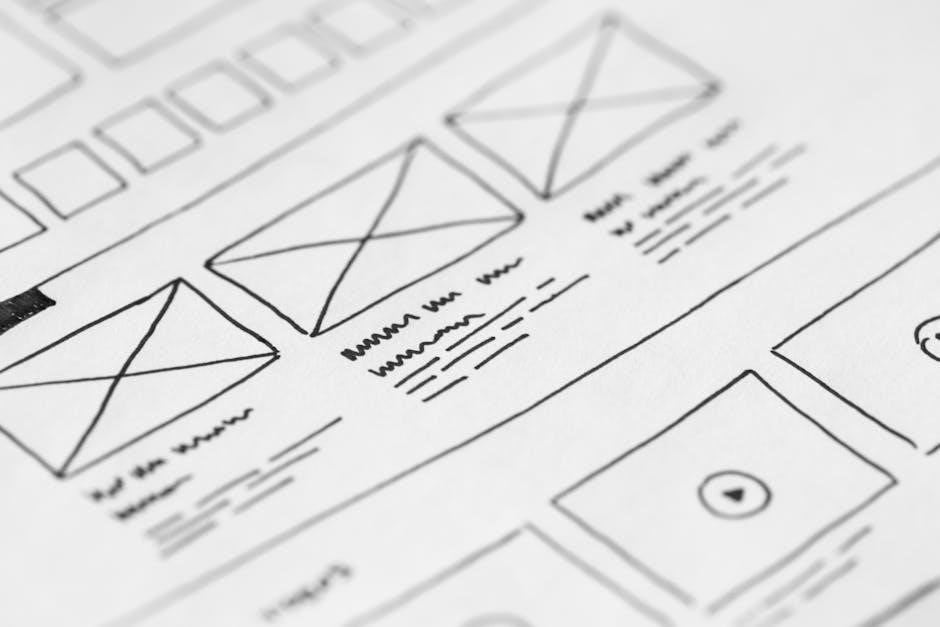This section introduces the concept of a “potager sur pied,” a raised garden bed. These elevated structures make gardening more accessible. It reduces strain on the back and knees. PDF plans provide detailed instructions to build these gardens.
What is a Potager Sur Pied?
A “potager sur pied” is essentially a raised garden bed, often designed to be waist-height or higher. This elevated structure brings the garden to you, eliminating the need to bend or kneel. It is ideal for individuals with mobility issues or limited space. These are typically constructed from wood, providing a contained area for soil and plants. They offer a practical and aesthetically pleasing gardening solution.
Benefits of Using a Potager Sur Pied
Using a “potager sur pied” offers numerous advantages. Primarily, it reduces physical strain, making gardening accessible to all ages and abilities. These elevated beds also improve soil quality control, prevent soil compaction, and offer better protection from pests. They warm up faster in spring, extending the growing season. Their contained nature is perfect for small spaces like balconies, patios, or areas with poor native soil. Finally, they add an aesthetic element to any outdoor space.
Finding and Downloading PDF Plans
This section focuses on locating PDF plans for building your own “potager sur pied.” It explores online resources. The section details websites, forums, and repositories. It will guide you in finding suitable downloadable plans.
Where to Find Potager Sur Pied PDF Plans
Finding “potager sur pied” PDF plans involves exploring various online platforms. Websites specializing in woodworking, gardening, and DIY projects are excellent starting points. Online forums and communities dedicated to gardening often share free plans; Platforms like Etsy and specialized online stores may offer paid plans. Search specifically for “potager sur pied plans PDF” for targeted results.
Free vs. Paid PDF Plans: What to Consider
When choosing between free and paid “potager sur pied” PDF plans, consider several factors. Free plans are readily accessible but might lack detail or clarity. Paid plans often provide more comprehensive instructions, material lists, and 3D visualizations. Assess your skill level and project complexity. Simpler projects may suit free plans. Complex designs may require the detailed guidance of paid plans for successful execution.

Understanding PDF Plan Components
This section will help you understand the typical components found in a “potager sur pied” PDF plan. Understanding this will allow you to interpret the plans, and know how to effectively construct your raised garden bed.
Key Elements Included in a Typical PDF Plan
Typical PDF plans for a “potager sur pied” include several key elements. These are essential for successful construction. You will find detailed diagrams showing the overall structure and individual components. There will be a list of materials with dimensions. Detailed cutting lists for lumber, and step-by-step assembly instructions are also included. These plans have safety precautions.
Interpreting Dimensions and Measurements
Accurately interpreting dimensions and measurements in a “potager sur pied” PDF plan is important. Look for unit consistency, such as inches, centimeters, or millimeters. Pay close attention to the overall dimensions of the structure. This ensures it fits your intended space. Double-check the measurements for individual boards or components before cutting. Precise measurements are vital for a stable and well-constructed garden bed.
Materials and Tools Required
This section details the necessary materials and tools for building a “potager sur pied.” The PDF plans will outline lumber, fasteners, and other components. It also lists essential tools for cutting, assembling, and finishing the raised garden bed.
Essential Materials for Constructing a Potager Sur Pied
Constructing a “potager sur pied” requires specific materials to ensure durability and functionality. The primary material is wood, with options including cedar, pine, or treated lumber. Fasteners like screws and nails are essential for assembly. A liner, made of landscape fabric or plastic, prevents soil contact with the wood, prolonging its life. Soil is needed to fill the bed. Corner brackets will add structural support.
Recommended Tools for Assembly
Assembling a “potager sur pied” efficiently requires specific tools. A saw, whether hand-powered or electric, is essential for cutting wood. A drill with various bits facilitates screwing pieces together. A measuring tape ensures accurate dimensions. A level guarantees the structure is even. Safety glasses and gloves protect during the construction process. A square helps create right angles. A staple gun secures the liner.
Construction Steps from PDF Plans
This part delves into the practical steps. You’ll learn how to construct your “potager sur pied” using readily available PDF plans. We’ll cover essential tips for ensuring stability and long-term durability of your raised garden.
Step-by-Step Guide to Building Your Potager Sur Pied
Begin by preparing all materials, cutting wood according to PDF dimensions, and assembling the frame. Secure corners with screws. Add a bottom to retain soil. Reinforce structure with supports. Consider adding a liner to protect the wood from moisture. Ensure proper drainage by drilling holes in the base. Finally, sand rough edges for a safe and polished finish.
Tips for Ensuring Stability and Durability
To enhance stability, select weather-resistant wood and apply a protective sealant. Use robust screws and corner brackets for strong joints. Reinforce the base with extra supports to bear the soil’s weight. Consider adding a permeable weed barrier to the bottom. Ensure adequate drainage to prevent wood rot. Regularly inspect and maintain the structure. Tighten loose screws and reapply sealant as needed.
Customization and Design Considerations
This section explores adapting potager sur pied PDF plans. Tailor dimensions to fit available space and personal needs. Consider aesthetics by choosing specific wood types, paint, or stain. Incorporate features like integrated watering systems or decorative elements.
Adapting PDF Plans to Suit Your Needs
Modifying PDF plans for a potager sur pied involves assessing your unique gardening requirements and physical space. Consider the height of the bed for comfortable access. Adjust the width and length to suit your available area, whether a balcony or a garden. Think about adding shelves for tools and consider your plant choices. Ensure structural integrity when altering dimensions.
Adding Personal Touches to Your Potager Sur Pied
Personalizing your potager sur pied enhances its aesthetic appeal and functionality. Consider painting or staining the wood to match your outdoor decor. Incorporate decorative elements like mosaic tiles or carved details. Add a trellis for climbing plants to create a vertical garden. Install a small watering system for convenience. Integrate storage solutions for tools and accessories, making it uniquely yours.
Optimizing Your Potager Sur Pied for Planting
To maximize yield, proper soil selection is key for your potager sur pied. Choose plants suited to the raised bed environment. Consider companion planting to enhance growth and deter pests. Regular watering and nutrient management are also essential.
Soil Selection and Preparation
The success of your potager sur pied relies heavily on selecting the right soil. A well-draining, nutrient-rich mix is crucial for healthy plant growth. Avoid using garden soil, as it can be too heavy and compact. Instead, opt for a blend of compost, peat moss, and vermiculite or perlite. This combination ensures proper aeration, moisture retention, and nutrient availability for your plants.
Choosing the Right Plants for Your Elevated Garden
Selecting appropriate plants is key to a thriving potager sur pied. Consider the available space and sunlight when making your choices. Compact varieties of vegetables, herbs, and flowers are ideal for raised beds. Opt for plants with shallow root systems to maximize space and nutrient uptake. Companion planting can also enhance growth and deter pests, creating a balanced ecosystem within your elevated garden.

Maintenance and Care Tips
Proper maintenance ensures a healthy and productive potager sur pied. This involves regular watering, appropriate fertilization, and consistent monitoring for pests. Preventative measures are crucial for long-term success. Addressing issues promptly keeps your elevated garden flourishing throughout the seasons.
Watering and Fertilizing Your Potager Sur Pied
Consistent watering is vital, especially in elevated beds that tend to dry out faster than in-ground gardens. Monitor soil moisture regularly and adjust watering frequency accordingly; Use a balanced fertilizer to provide essential nutrients, tailored to the specific plants you are growing. Consider organic options to promote soil health and sustainable gardening practices. Avoid over-fertilizing, which can harm plants and the environment. Proper watering and fertilization are key to abundant growth.
Preventing Pests and Diseases
Regularly inspect your elevated garden for signs of pests or diseases. Implement preventative measures like companion planting to deter pests naturally. Ensure good air circulation to reduce the risk of fungal diseases. Use organic pest control methods, such as neem oil or insecticidal soap, when necessary. Remove any diseased plant material promptly to prevent further spread. Maintaining a healthy soil environment also strengthens plants’ resistance to pests and diseases, promoting a thriving garden.
Examples of Potager Sur Pied Designs
This section explores diverse “potager sur pied” designs. Ranging from classic to modular configurations, it caters to various needs. Stair-step designs suit sloped terrains. Designs also incorporate rainwater harvesting. These examples offer inspiration for personalizing your garden.
Different Styles and Configurations
This section showcases the versatility of “potager sur pied” designs. It emphasizes different styles and configurations. Classic square or rectangular designs are simple and effective. Modular systems offer flexibility and scalability, adapting to changing needs. Tiered or staircase designs are ideal for sloped terrains. Some designs integrate features like built-in composters or tool storage. Others prioritize aesthetics with decorative elements.
Inspiration from Real-Life Projects
This section provides inspiration through real-life examples of “potager sur pied” projects. These examples demonstrate the practical application of PDF plans. They highlight the diverse ways individuals have customized their gardens. They adapted designs to suit their unique spaces and gardening goals. Projects may feature innovative solutions. They might include repurposed materials or creative planting arrangements. These real-world examples motivate and guide readers in their own builds.

Troubleshooting Common Issues
This section addresses typical problems encountered while constructing. It includes environmental challenges with a “potager sur pied.” It provides solutions to ensure a successful gardening experience. It offers guidance for overcoming obstacles.
Addressing Construction Challenges
This section focuses on resolving difficulties during the building phase. It tackles issues like uneven ground and material shortages. Warped wood and incorrect measurements are also discussed. Solutions include shimming for stability and adapting designs. It suggests improvising with materials. Ensuring square corners and proper drainage are critical. Seeking advice from online communities is recommended. It promotes precise cutting and secure fastening techniques.
Dealing with Environmental Factors
This segment addresses how weather impacts your “potager sur pied.” It provides tips for managing sun exposure and heavy rainfall. Protecting against frost and strong winds is essential. Soil erosion and temperature fluctuations are considered. Recommendations include using shade cloths and windbreaks. Selecting weather-resistant materials is advised. Proper drainage and soil amendments are covered. Pest control and disease prevention strategies are also discussed. Adapting watering schedules to climate conditions is emphasized for optimal plant health.

Resources and Support
This section directs readers to resources for “potager sur pied” construction. Online forums and communities are listed. Additional learning materials, such as books and videos, are suggested. Local gardening clubs and experts can offer support.
Online Communities and Forums
Engaging with online communities and forums can greatly enhance your experience with “potager sur pied” projects. These platforms offer a space to connect with fellow gardeners, share experiences, and seek advice. You can find valuable insights, troubleshoot issues, and gain inspiration from others’ projects. Look for forums dedicated to raised bed gardening or specific to “potager sur pied” designs. Active participation can provide ongoing support and learning opportunities.
Additional Learning Materials
To deepen your understanding of “potager sur pied” gardening, explore additional learning materials. Websites and blogs provide articles, guides, and videos covering various aspects of raised bed gardening. Look for resources on soil composition, plant selection, pest control, and seasonal gardening tips. Books dedicated to raised bed gardening can offer comprehensive knowledge and practical advice. Consider workshops or online courses to gain hands-on experience and learn from experts in the field, enhancing skills.
Enjoying Your Potager Sur Pied
Building and using a “potager sur pied” offers immense satisfaction. It combines the joy of construction with the rewards of gardening. It is a fulfilling experience. Enjoy fresh produce and the beauty of your own creation.
The Satisfaction of Building and Growing
The process of constructing a “potager sur pied” from a PDF plan offers a unique sense of accomplishment. Seeing the project come to life from raw materials is deeply rewarding. Nurturing plants from seeds or seedlings to harvestable produce further enhances this satisfaction. The act of growing your own food connects you with nature. It provides fresh, healthy ingredients for your table and mind.
Expanding Your Gardening Knowledge
Embarking on a “potager sur pied” project opens doors to a wealth of gardening information. Learning about soil composition, plant selection, and pest management becomes essential. You will delve into topics like companion planting, crop rotation, and the benefits of organic gardening. Each challenge and success is a valuable learning experience. It enriches your understanding of the natural world, and fosters a deeper appreciation for the process of growth.
